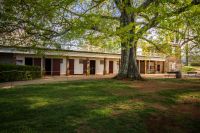Monticello's North Dependency Reconstruction Underway


Every restoration architect dreads leaky roofs, unstable foundations, and finding a document filled with important details after a project is finished. Milton Grigg – the architect who designed the restoration of Monticello’s North Dependency in 1940 – successfully reconstructed a functional roof and stable foundation. However, an important Jefferson memo was discovered after the project was completed that called into question almost everything Grigg designed.

The North Dependency was started in 1802 when Hugh Chisolm, a white mason, was hired to build a stone retaining wall. This wall was the only surviving element of the Jefferson’s North Dependency when Grigg started reconstruction. For his design, Grigg relied on Jefferson documents that indicated the dependency was covered by a serrated roof topped by a wooden deck. What Grigg did not know at the time was the original floor plan or how Jefferson intended to use the spaces. Since Jefferson’s earlier 1770s plans for the North Dependency clearly included stables, Grigg had good reason to believe that Jefferson would have built horse stalls under Monticello’s North Terrace. Grigg undertook an archaeological excavation in hopes of finding more information. Unfortunately, his excavations only revealed what might have been a piece of the Jefferson-era framing but not much else. With little information available on what Jefferson’s stables would have looked like, Grigg decided to base his plans largely on an early-19th century stable in Fluvanna County built by Jefferson’s friend John Hartwell Cocke. Using these sources, Grigg worked to design as accurate a reconstruction as possible. He was in for a surprise when historian Edwin Betts transcribed a document known to historians as N-540 a year after the construction was completed.

The document discovered by Betts was an amazing find. It not only carefully detailed how Jefferson wanted the rooms in the North Dependency to be laid out, but the document also clearly indicated that the spaces were to be principally used for storing carriages instead of horses. Other documents including a drawing by Jefferson’s granddaughter Cornelia Randolph confirm that the North “offices” were primarily used as coach rooms. Alas, Grigg’s had gotten it wrong – his restoration did not portray the North Dependency as it would have been in Jefferson’s day.
Thanks to support from David M. Rubenstein and the Manning Family Foundation, we are now able to reconstruct the North Dependency according to Jefferson’s original plans. Using N-540, architectural historians and architects were able to design historically accurate walls and partitions. Other details – such as the exterior siding, strap hinges, padlocks, and doors – were all selected based on surviving historic examples or Jefferson’s documents. [Fig. 4: Strap hinge from wine cellar]
After the reconstruction is finished this fall, the restored North Dependency will feature two new exhibit spaces focused on the enslaved workers who built Jefferson’s carriages, the carriages themselves, and transportation in the early-19th century. An exciting new gift shop along with new bathrooms will also be built behind the carefully reconstructed facade. The move of the restrooms to the north side is particularly important because it will allow for the restoration of the South Dependency’s slave quarters and dairy along with the South Pavilion cellar.

Do we worry that a great document will be found soon after we finish our reconstruction? We don’t. Finding another account describing the North Dependency would be incredibly exciting. Until that time, guests who visit Monticello each year will soon be able to discover an even richer and more accurate story about the people who lived and worked on the mountaintop in Jefferson’s time.
The Mountaintop Project is made possible by a transformational contribution from David M. Rubenstein. Leading support was provided by Fritz and Claudine Kundrun, along with generous gifts and grants from the Sarah and Ross Perot, Jr. Foundation, the Robert H. Smith Family Foundation, Mr. and Mrs. John H. Birdsall, Mr. and Mrs. B. Grady Durham, the Mars Family, the Richard S. Reynolds Foundation, the National Endowment for the Humanities, Charlotte Moss and Barry Friedberg, the Joseph and Robert Cornell Memorial Foundation, the Mary Morton Parsons Foundation, the Cabell Foundation, the Garden Club of Virginia, and additional individuals, organizations, and foundations.



